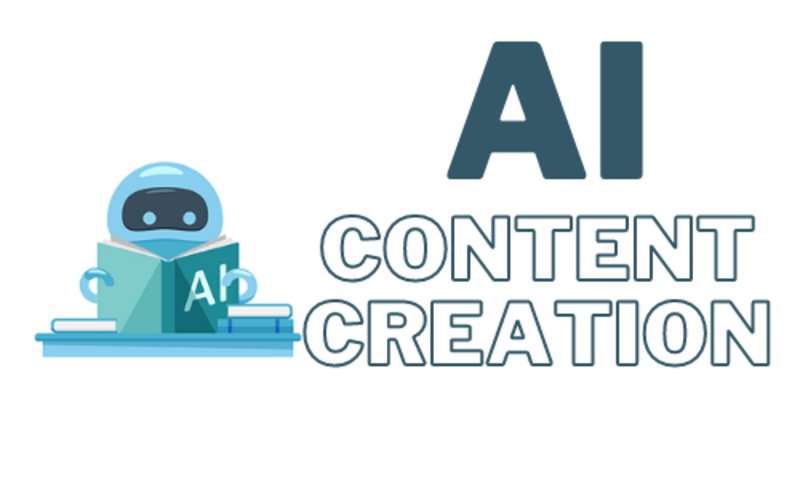Creating content can be challenging and time-consuming. You need to come up with ideas, do your research, write drafts, and edit until your content shines. But what if you had a tool that could make this process faster and easier? This is where artificial intelligence (AI) steps in. In this beginner’s guide, we will explore how you can use AI in content creation to save time, enhance quality, and stay ahead of the competition.
Understanding AI in Content Creation
What Is AI in Content Creation?
AI in content creation refers to using artificial intelligence technologies to generate, edit, and optimize written content. These tools can help you create blog posts, social media updates, product descriptions, and more.
AI works by analyzing patterns in large amounts of text data and then using that information to produce human-like content.
Why Use AI for Content Creation?
AI tools can significantly streamline your content creation process. They can help you generate ideas, write drafts, optimize for SEO, and even check for grammar and style issues.
This not only saves time but also ensures that your content is polished and professional. For beginners, AI tools can be a game-changer, making the daunting task of content creation much more manageable.
Getting Started with AI Content Tools
Understanding Your Content Needs
Before diving into AI tools, it’s essential to have a clear understanding of your content needs. Identify the types of content that drive the most value for your business.
This could be blog posts, social media content, email newsletters, or video scripts. Analyze your current content strategy to pinpoint areas where AI can offer the most significant improvement, such as speeding up the writing process, enhancing SEO, or personalizing content for different audience segments.
This clarity will guide your choice of AI tools and how you implement them.
Researching and Selecting AI Tools
Selecting the right AI tool is crucial for maximizing benefits. Start by researching available tools, reading reviews, and even joining online forums or communities where users discuss their experiences. Look for tools that specialize in your areas of need.
For example, if SEO optimization is your primary focus, tools like Clearscope or MarketMuse might be beneficial. For generating content, Jasper and Copy.ai are popular choices. Evaluate these tools based on their features, ease of use, and how well they integrate with your existing systems.
Setting Up AI Tools for Maximum Efficiency
Once you’ve chosen your AI tools, setting them up correctly is key to ensuring efficiency. Begin by integrating these tools with your existing content management systems and workflows.
This might involve linking your AI tool to your CMS, social media platforms, or email marketing software. Take advantage of any onboarding resources provided by the AI tool, such as tutorials, webinars, or customer support.
These resources can help you and your team get up to speed quickly and start seeing results faster.
Customizing AI Settings
AI tools often come with customizable settings that allow you to tailor their output to match your brand’s voice and style. Spend time tweaking these settings.
For instance, you can adjust the tone to be more formal or casual, specify preferred language and terminology, and set parameters for content length and structure.
Providing the AI with detailed guidelines and examples of your best content can help it produce better results. Regularly update these settings based on feedback and performance to keep the AI aligned with your evolving brand voice.
Training Your Team
For startup founders, ensuring that your team is comfortable and proficient with AI tools is critical. Organize training sessions where team members can learn how to use the tools effectively.
Encourage them to experiment with different features and use cases to understand the full potential of the AI. Create a collaborative environment where team members can share tips, challenges, and successes with AI tools.
Continuous learning and adaptation are vital to making the most of AI in your content creation process.
Monitoring and Adjusting AI Performance
After setting up and customizing your AI tools, it’s important to continuously monitor their performance. Use analytics to track how well AI-generated content performs compared to manually created content.
Pay attention to key metrics such as engagement rates, conversion rates, and SEO rankings. Use these insights to make necessary adjustments. If certain types of content or settings are not performing as expected, tweak the AI inputs and guidelines accordingly.
This iterative process helps in fine-tuning the AI’s output to better meet your goals.
Establishing a Feedback Loop
Creating a feedback loop is essential for continuous improvement. Encourage your team to provide regular feedback on AI-generated content.
Collect this feedback systematically, and use it to refine the AI’s settings and inputs. Regularly update the training data for your AI tool with new examples and guidelines to keep it aligned with your brand’s evolving needs.
A well-established feedback loop ensures that the AI tool continuously learns and improves, enhancing the overall quality and effectiveness of your content.
Planning for Scalability
As your startup grows, your content needs will expand. Plan for scalability by choosing AI tools that can grow with you. Opt for tools that offer flexible pricing plans and can handle increased volumes of content without compromising on quality.
Ensure that your AI tools integrate seamlessly with other systems and platforms you might adopt in the future. By planning for scalability from the outset, you can avoid disruptions and maintain a consistent content strategy as your business evolves.
Leveraging AI for Strategic Insights
Beyond just creating content, AI tools can provide strategic insights that inform your overall content strategy. Use AI analytics to identify trends, understand audience preferences, and predict future content needs.
These insights can help you make data-driven decisions about what types of content to produce, when to publish, and which channels to use. By leveraging AI for strategic insights, you can stay ahead of trends and continuously refine your content strategy for better results.
Ensuring Compliance and Ethics
As you integrate AI into your content creation process, it’s crucial to ensure that you remain compliant with relevant regulations and ethical standards.
Be transparent about the use of AI in your content creation process, especially if it impacts your audience’s experience. Ensure that your AI tools adhere to data privacy laws and guidelines, such as GDPR.
Additionally, promote ethical use of AI by avoiding the spread of misinformation and ensuring that your content is fair and unbiased. Upholding high ethical standards builds trust with your audience and enhances your brand’s reputation.
Using AI for Content Creation
Brainstorming Content Ideas
One of the first steps in content creation is coming up with ideas. AI tools can help by generating a list of potential topics based on your keywords or themes.
For example, if you want to write about digital marketing, you can input this keyword, and the AI will suggest various angles and subtopics. This can be especially useful if you’re struggling with writer’s block or need to fill up your content calendar.
Drafting Content
AI tools can also help draft your content. Start by providing your input—such as the topic, key points you want to cover, and any specific instructions. The AI will generate a draft that you can then refine.
This initial draft can save you hours of writing time and give you a solid foundation to build upon. Remember, the AI’s draft is a starting point; you should still review and edit to ensure it meets your quality standards.
Optimizing Content for SEO
Search engine optimization (SEO) is crucial for making your content visible online. AI tools can assist with keyword research, suggesting keywords that have high search volume and low competition.
They can also help you optimize your content by recommending where to place these keywords for maximum impact. Additionally, some AI tools can analyze your content for readability and structure, ensuring it’s user-friendly and optimized for search engines.
Editing and Polishing
Once your draft is complete, it’s time to edit and polish. AI tools like Grammarly can check for grammar and spelling errors, while tools like Hemingway can help improve readability.
These tools provide suggestions to make your writing clearer and more concise. Even though AI can catch many issues, it’s still important to do a final manual review to add your personal touch and ensure everything reads naturally.
Enhancing Content with Visuals
While written content is crucial, adding visuals can significantly enhance engagement. AI tools can help here too. Tools like Canva use AI to suggest design elements and layouts that match your content’s theme.
You can quickly create infographics, social media posts, and other visual aids that complement your written content. AI can even help in creating video content by suggesting scripts and editing clips, making it easier to produce high-quality multimedia content.
Personalizing Content for Different Audiences
Personalization is key to engaging your audience effectively. AI tools can analyze user data to help you understand different segments of your audience. By understanding their preferences and behaviors, you can tailor your content to meet their specific needs.
Tools like HubSpot and Marketo use AI to automate this process, enabling you to deliver personalized content at scale. Whether you’re targeting different demographics or customer personas, AI can ensure your message resonates with each group.
Managing Content Distribution
Creating content is only half the battle; getting it in front of your audience is equally important. AI tools can optimize your content distribution by analyzing the best times to post and the most effective channels to use.
Platforms like Buffer and Hootsuite use AI to schedule posts for maximum engagement. They can also provide insights into how your content is performing across different channels, helping you refine your strategy and ensure your content reaches the right people.
Best Practices for Using AI Tools

Maintaining a Human Touch
While AI can automate many aspects of content creation, it’s essential to maintain a human touch. AI-generated content can sometimes feel robotic or lack the nuance that human writers bring.
Always review and edit AI-generated content to ensure it aligns with your brand voice and connects with your audience on a personal level. Incorporate anecdotes, humor, and insights that only a human can provide to make your content more relatable and engaging.
Combining AI with Human Creativity
The best results come from combining AI efficiency with human creativity. Use AI to handle repetitive and time-consuming tasks, allowing you to focus on creative and strategic aspects.
For example, let AI generate the first draft and then refine it with your unique perspective and ideas. This collaboration can produce high-quality content faster while ensuring it remains authentic and engaging.
Staying Updated with AI Developments
AI technology is constantly evolving, with new features and improvements being released regularly. Stay updated with the latest developments in AI content tools to make the most of their capabilities.
Participate in webinars, follow industry blogs, and join online communities to learn about new trends and best practices. By keeping up with AI advancements, you can continuously improve your content creation process and stay ahead of the competition.
Setting Clear Goals and Measuring Performance
To effectively use AI tools, set clear goals for your content. Define what you want to achieve—whether it’s increasing website traffic, boosting engagement, or generating leads.
Use AI analytics tools to measure the performance of your content against these goals. Track key metrics such as page views, time on page, bounce rates, and conversion rates.
Analyzing this data can provide valuable insights into what’s working and what needs improvement, helping you refine your strategy and achieve better results.
Ensuring Ethical AI Use
Ethical considerations are crucial when using AI tools. Ensure your content is original and does not infringe on any copyrights. Use AI responsibly by avoiding misleading or false information.
Be transparent with your audience about the use of AI in your content creation process. This builds trust and ensures that your content maintains its integrity and authenticity.
Overcoming Challenges with AI Content Creation
Addressing Writer’s Block
Writer’s block can be a significant hurdle in content creation. AI tools can help by generating content ideas and initial drafts, giving you a starting point. If you’re stuck, input a few keywords related to your topic, and let the AI suggest different angles or subtopics.
This can spark your creativity and help you overcome the initial block, making it easier to continue writing.
Ensuring Originality
Originality is essential for standing out and maintaining credibility. While AI tools can help generate content, it’s important to ensure that the output is unique.
Use plagiarism detection tools like Copyscape to check for duplicate content. Add your personal insights, experiences, and voice to the AI-generated draft to make it truly original.
This combination of AI efficiency and human originality can produce content that is both engaging and distinctive.
Maintaining Quality and Consistency
Quality and consistency are key to a successful content strategy. AI tools can help maintain consistency by following the guidelines and tone you set. However, quality control still requires human oversight.
Regularly review and edit AI-generated content to ensure it meets your standards. Establish a content review process that includes multiple rounds of editing and feedback. This ensures that every piece of content you publish is polished and professional.
Advanced Techniques for AI Content Creation
Leveraging AI for Advanced SEO Strategies
SEO is a critical component of content creation, and AI can significantly enhance your SEO efforts. Use AI tools like Clearscope or MarketMuse to conduct in-depth keyword analysis and competitive research.
These tools can help identify gaps in your content and suggest keywords and topics that your competitors might be missing. Additionally, AI can analyze your existing content to ensure it meets the latest SEO best practices, such as keyword density, semantic relevance, and readability.
Creating Content Clusters
Content clusters involve creating a comprehensive piece of pillar content on a broad topic and supporting it with several related subtopics. AI tools can help you identify potential topics for your content clusters by analyzing search data and user queries.
Once you have your topics, use AI to draft the main pillar content and the accompanying subtopics. This approach not only improves your SEO but also provides your audience with valuable, in-depth information.
Enhancing User Experience with AI
User experience (UX) is an often-overlooked aspect of content creation. AI tools can help analyze user behavior on your site and provide insights into how users interact with your content.
Tools like Hotjar use AI to create heatmaps that show where users click and scroll on your pages. Use these insights to optimize your content layout, ensuring it is easy to navigate and engaging for your audience.
Improving UX can lead to higher engagement rates and better SEO performance.
Automating Social Media Content
Social media is a vital channel for content distribution. AI tools like Buffer and Hootsuite can automate your social media posts, ensuring consistent and timely updates.
These tools analyze your audience’s behavior to determine the best times to post and the most effective types of content. By automating your social media strategy with AI, you can maintain an active online presence without the constant manual effort.
Personalizing Email Campaigns
Email marketing remains one of the most effective ways to engage with your audience. AI tools can personalize your email campaigns by analyzing user data and behavior.
Tools like Mailchimp use AI to segment your audience and tailor your email content to different user groups. Personalized emails can significantly improve open and click-through rates, driving more traffic to your site and increasing conversions.
Integrating AI with Analytics Tools
To fully leverage AI in content creation, integrate your AI tools with analytics platforms like Google Analytics. This integration allows you to track the performance of your AI-generated content in real-time.
Analyze metrics such as traffic, bounce rates, and user engagement to understand how your content is performing. Use these insights to refine your content strategy continuously, ensuring that your content remains relevant and effective.
Adapting Content for Voice Search
With the rise of voice search, optimizing your content for voice queries is becoming increasingly important. AI tools can help you understand the natural language patterns used in voice searches.
Use this information to adapt your content, making it more conversational and answering common questions directly. This approach can improve your chances of appearing in voice search results, driving more traffic to your site.
Success Stories with AI Content Creation

Small Business Success
A small business owner used AI tools to enhance their content marketing strategy. By leveraging AI for keyword research and content optimization, they saw a significant increase in organic traffic.
The AI-generated content was refined by human editors, ensuring it resonated with their target audience. This hybrid approach led to higher engagement and conversion rates, helping the business grow.
E-commerce Enhancement
An e-commerce company used AI to generate product descriptions and blog posts. The AI tools helped them produce large volumes of content quickly, keeping their website updated and relevant. By optimizing this content for SEO, they improved their search engine rankings, which resulted in increased visibility and sales.
The time saved by using AI allowed the company to focus on other strategic areas of their business.
Content Agency Efficiency
A content agency integrated AI tools into their workflow to manage a growing number of client projects. AI assisted in generating initial drafts and conducting keyword research, which were then polished by the agency’s writers.
This approach enabled the agency to take on more clients without compromising on quality. The efficiency gained through AI integration led to increased revenue and client satisfaction.
Future Trends in AI Content Creation
Advancements in Natural Language Processing (NLP)
Natural Language Processing (NLP) is at the core of AI content creation. As NLP technology continues to advance, AI tools will become even more adept at understanding context, tone, and nuance.
This will result in more sophisticated and human-like content generation, making AI an even more valuable tool for content creators.
Increased Personalization
Future AI tools will offer even greater personalization capabilities. By analyzing user data in more depth, AI will be able to create highly personalized content tailored to individual preferences and behaviors.
This level of personalization will enhance user engagement and improve conversion rates.
Integration with Other Technologies
AI content creation tools will increasingly integrate with other emerging technologies, such as virtual reality (VR) and augmented reality (AR).
This will open up new possibilities for creating immersive and interactive content experiences. Staying informed about these integrations can help you explore innovative ways to engage your audience.
Ethical Considerations and Transparency
As AI becomes more integrated into content creation, ethical considerations will gain importance. Ensuring transparency, avoiding misinformation, and respecting user privacy will be key challenges.
Adopting ethical guidelines and staying informed about industry standards will help you use AI responsibly and maintain your audience’s trust.
Practical Steps to Implement AI in Content Creation
Conducting a Needs Assessment
Before implementing AI tools, conduct a thorough needs assessment to understand where AI can have the most significant impact. Evaluate your current content creation process to identify bottlenecks, repetitive tasks, and areas that require improvement.
This assessment will help you pinpoint the specific AI tools and features that can address your unique challenges and enhance your overall efficiency.
Integrating AI into Your Existing Workflow
Successful integration of AI tools requires a seamless blend into your existing workflow. Start by incorporating AI tools gradually, focusing on one area at a time.
For instance, you might begin with AI-assisted keyword research and gradually move to drafting and editing. Ensure that your team is trained on how to use these tools effectively.
Regular training sessions and workshops can help your team become comfortable with AI and maximize its potential.
Creating a Feedback Loop for Continuous Improvement
AI tools improve over time with more data and feedback. Establish a feedback loop where your team consistently reviews AI-generated content and provides input on what works and what doesn’t.
Use this feedback to train your AI tools further, refining their algorithms to better match your brand voice and content needs. Continuous improvement is key to leveraging AI tools effectively.
Managing AI Content with Human Oversight
Human oversight is crucial to ensure the quality and relevance of AI-generated content. Assign team members to review and edit all AI-produced drafts, adding a human touch and ensuring the content aligns with your brand’s message and tone.
This oversight not only maintains quality but also helps in identifying patterns that can improve the AI’s performance over time.
Experimenting with Different Content Formats
AI tools are versatile and can be used to create various types of content, including blog posts, social media updates, email newsletters, and video scripts. Experiment with different formats to see where AI can add the most value.
For example, you might find that AI excels in generating engaging social media content, allowing you to focus more on long-form articles and strategic planning.
Addressing Common Concerns with AI Content Creation
Quality Control
One of the primary concerns with AI-generated content is quality control. While AI tools can produce well-structured drafts, they might not always capture the subtle nuances of human language.
Regularly reviewing and editing AI content ensures it meets your quality standards. Additionally, using AI as a collaborative tool rather than a complete replacement for human writers can help maintain high-quality content.
Maintaining Brand Voice
Maintaining a consistent brand voice is essential for effective communication. Train your AI tools by feeding them examples of your best-performing content.
Clearly define your brand voice and style guidelines and ensure these are integrated into the AI’s learning process. Regularly update the AI with new content examples to keep it aligned with any changes in your brand’s voice or strategy.
Ensuring Data Privacy and Security
Data privacy and security are critical when using AI tools. Choose reputable AI providers with strong data protection measures. Ensure that any data you share with AI tools is anonymized and complies with privacy regulations such as GDPR.
Regularly audit your AI tools and processes to ensure compliance with data security standards.
Managing Costs
While AI tools can save time and enhance efficiency, they also represent an investment. Manage costs by choosing AI tools that offer flexible pricing plans. Start with essential features and scale up as you see tangible benefits.
Regularly evaluate the return on investment (ROI) from your AI tools to ensure they are providing value for your business.
The Future of AI in Content Creation

AI and Augmented Writing
The future of AI in content creation lies in augmented writing, where AI assists writers in real-time. Emerging tools are starting to offer features like real-time grammar checks, style suggestions, and content optimization tips as you write.
This technology will make the writing process even more seamless and efficient, blending human creativity with AI’s analytical power.
AI in Multilingual Content Creation
As businesses expand globally, the need for multilingual content is growing. AI tools are advancing in their ability to create content in multiple languages, making it easier to reach diverse audiences.
In the future, AI could help generate and optimize content for different languages and cultures, ensuring your message resonates worldwide.
AI and Predictive Analytics
Predictive analytics is another area where AI is making strides. By analyzing user behavior and engagement patterns, AI can predict which types of content are likely to perform well.
This predictive capability can help you plan your content strategy more effectively, focusing on topics and formats that are likely to drive higher engagement and conversions.
Ethical AI Development
The ethical development of AI is becoming increasingly important. Future AI tools will likely incorporate more robust ethical guidelines to ensure transparency, fairness, and accountability.
Businesses using AI will need to stay informed about these developments and integrate ethical considerations into their AI strategies.
Wrapping it up
AI in content creation offers immense opportunities for startups to enhance efficiency, quality, and engagement. By strategically selecting and implementing AI tools, providing detailed briefs, and maintaining a balance between automation and personalization, you can create compelling content that resonates with your audience.
Regular updates, collaboration, and consistency are key to maximizing the benefits of AI. Additionally, leveraging AI for audience insights and staying adaptable to AI-driven trends will keep your content strategy ahead of the curve. Embrace AI as a powerful ally in your content creation journey, and drive growth and success for your business.
READ NEXT:
- How to Attract More Customers to Your Bar and Restaurant
- Creative SMS Marketing Campaign Ideas
- How to Market Food Products Effectively
- How to Start the New Year with Fresh Marketing Strategies
- Effective Marketing Strategies for Garage Door Companies





















Comments are closed.